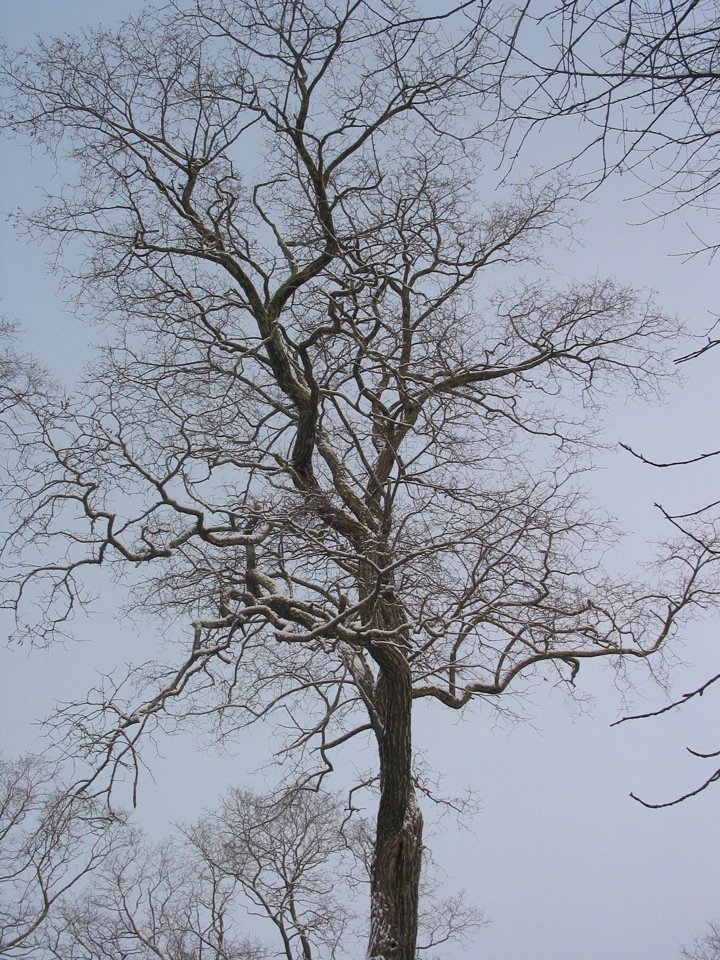It is rainy and dark as I dash to the house, pushing the door shut against the buffeting wind. No, it is not a dark and stormy night, merely rainy and dark. I flick on the light and see dozens of black forms flattened on the freshly cleaned floors. It is October, and the annual battle has begun.
About an inch and a half long, brownish-green oval leaves from the locust trees insist on covering the dining room and kitchen, encroach on the living room, cozy down in front of the fire and the boldest cheekily dot the way up the stairs. Damp, they plaster themselves to the wood, and firmly resist being swept up. Instead, I stoop and pick them up one by one.
Wiping feet outside the door and again on a mat inside makes little difference. I leave in the morning, floor cleared, and upon return find they have invaded again. The door may have been opened for the cat, or someone dropped something off, and those leaves seized the opportunity to scurry in.
Black Locust, Robinia pseudoacacia are not native to Maine. They have moved up from Southern New England. They are widespread now, however, but primarily in areas where they has been a long history of human habitation.
The ones around my house in Otter Creek are over one hundred years old. They seem startlingly out of place, with their dark twisting branches suggestive of exotic rainforests rather than our homely Maine woods. Even more out of place since they surround my house but not the homes nearby, fifteen or more of them, and they tower above the poplar, ash and apple at neighboring houses.
I was not familiar with their habits when I purchased this house fifteen years ago. I had stretched my finances to the limit, and was counting dollars as I replaced rotten windows and had plumbing for a kitchen sink installed. I bought the house in May, and watched in dismay as the neighbor’s trees burst forth with vivid chartreuse baby leaves, and my locusts remained black, stolid and leafless.

Corkscrew branches of the Black Locust
Daily I would look up, hoping for signs of life. Then resolutely ignore them and work on fixing stairs and laying floors. With each passing day it became more difficult to forget about them. I began to do addition in my head, tree removal at what? 500 dollars a tree? Probably optimistic. It just was not in the budget.
I counted the trees, cursing them, and wondered what to do without. Sheetrock in the bedroom? A sink in the lavatory? There wasn’t much room for budget cuts. And then, well into June, leaves and cottony white blossoms appeared. I blessed those trees, and thanked them. And finally got to know them. It is not an easy relationship.
In late winter I admire their bare, alien, corkscrew branches dark against the sky. And then I spend spring picking up the speckled snake-like branches littering the lawn. After I have cleared the yard, I am rewarded with magnificent creamy white blossoms, and the hum of bees is lovely and loud.

Followed by browning petals falling and sticking to everything and tracking into the house just like their autumn brothers. But soon green leaves unfurl like mimosa fronds, a delight to watch in the breeze, delicate and fine compared to their cruder companions, maple, oak and ash.
Some small green worms thrive on these leaves, and before long tiny black worm droppings are scattered over my white car. If not removed swiftly, moisture causes them to leave small bloodlike spots all over the surface and even a professional car wash is inadequate to remove these tough stains. Bleach and elbow grease are the only remedies– I park across the street at a neighbor’s. Two months after all our other trees have leafed out, the locust has finally stabilized for the summer. By August I gaze up and admire, pretending to have forgotten the spring struggle of sticky petals and bleach and worm droppings.
This peaceful truce does not last long. September, as other leaves turn autumnal shades of orange and gold, the Acacia gets dull and brown. Long before the maple starts to drop its leaves, the locust leaves fall down in a flurry. They lie on the ground and I step over them into the house, aware they quiescent, waiting. I sense their vast numbers, murmuring to each other. With the October winds they arise, and we battle again. They slip in the door and gain as much territory as they can, I stoop over and pad about the house picking them off one-by-one. By November they will be routed. I will have a few months peace to sit outside in a chair in the snow, a bonfire sending sparks up like fireflies through their beautiful branches. Guests frequently look up and admire our grove of trees, and the spiral shapes seventy feet above us.
“How lucky you are,” they say. Yes, I am. I know that. But I cannot help casting a frowning glance at those giants bending over us. Then I toss one of their limbs into the bonfire.
